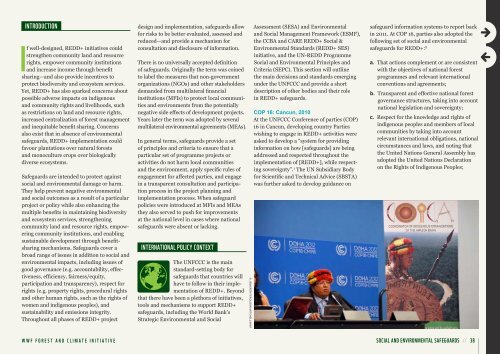WWF Guide to Building REDD+ Strategies
WWF Guide to Building REDD+ Strategies
WWF Guide to Building REDD+ Strategies
Create successful ePaper yourself
Turn your PDF publications into a flip-book with our unique Google optimized e-Paper software.
intRoduCtion<br />
if well-designed, <strong>REDD+</strong> initiatives could<br />
strengthen community land and resource<br />
rights, empower community institutions<br />
and increase income through benefit<br />
sharing—and also provide incentives <strong>to</strong><br />
protect biodiversity and ecosystem services.<br />
Yet, <strong>REDD+</strong> has also sparked concerns about<br />
possible adverse impacts on indigenous<br />
and community rights and livelihoods, such<br />
as restrictions on land and resource rights,<br />
increased centralization of forest management<br />
and inequitable benefit sharing. Concerns<br />
also exist that in absence of environmental<br />
safeguards, <strong>REDD+</strong> implementation could<br />
favour plantations over natural forests<br />
and monoculture crops over biologically<br />
diverse ecosystems.<br />
Safeguards are intended <strong>to</strong> protect against<br />
social and environmental damage or harm.<br />
They help prevent negative environmental<br />
and social outcomes as a result of a particular<br />
project or policy while also enhancing the<br />
multiple benefits in maintaining biodiversity<br />
and ecosystem services, strengthening<br />
community land and resource rights, empowering<br />
community institutions, and enabling<br />
sustainable development through benefitsharing<br />
mechanisms. Safeguards cover a<br />
broad range of issues in addition <strong>to</strong> social and<br />
environmental impacts, including issues of<br />
good governance (e.g. accountability, effectiveness,<br />
efficiency, fairness/equity,<br />
participation and transparency), respect for<br />
rights (e.g. property rights, procedural rights<br />
and other human rights, such as the rights of<br />
women and indigenous peoples), and<br />
sustainability and emissions integrity.<br />
Throughout all phases of <strong>REDD+</strong> project<br />
design and implementation, safeguards allow<br />
for risks <strong>to</strong> be better evaluated, assessed and<br />
reduced—and provide a mechanism for<br />
consultation and disclosure of information.<br />
There is no universally accepted definition<br />
of safeguards. Originally the term was coined<br />
<strong>to</strong> label the measures that non-government<br />
organizations (NGOs) and other stakeholders<br />
demanded from multilateral financial<br />
institutions (MFIs) <strong>to</strong> protect local communities<br />
and environments from the potentially<br />
negative side effects of development projects.<br />
Years later the term was adopted by several<br />
multilateral environmental agreements (MEAs).<br />
In general terms, safeguards provide a set<br />
of principles and criteria <strong>to</strong> ensure that a<br />
particular set of programme projects or<br />
activities do not harm local communities<br />
and the environment, apply specific rules of<br />
engagement for affected parties, and engage<br />
in a transparent consultation and participation<br />
process in the project planning and<br />
implementation process. When safeguard<br />
policies were introduced at MFIs and MEAs<br />
they also served <strong>to</strong> push for improvements<br />
at the national level in cases where national<br />
safeguards were absent or lacking.<br />
inteRnational PoliCy Context<br />
The UNFCCC is the main<br />
standard-setting body for<br />
safeguards that countries will<br />
have <strong>to</strong> follow in their implementation<br />
of <strong>REDD+</strong>. Beyond<br />
that there have been a plethora of initiatives,<br />
<strong>to</strong>ols and mechanisms <strong>to</strong> support <strong>REDD+</strong><br />
safeguards, including the World Bank’s<br />
Strategic Environmental and Social<br />
© JENNIFER FERGUSON-MITCHELL/<strong>WWF</strong><br />
Assessment (SESA) and Environmental<br />
and Social Management Framework (ESMF),<br />
the CCBA and CARE <strong>REDD+</strong> Social &<br />
Environmental Standards (<strong>REDD+</strong> SES)<br />
initiative, and the UN-REDD Programme<br />
Social and Environmental Principles and<br />
Criteria (SEPC). This section will outline<br />
the main decisions and standards emerging<br />
under the UNFCCC and provide a short<br />
description of other bodies and their role<br />
in <strong>REDD+</strong> safeguards.<br />
COP 16: Cancun, 2010<br />
At the UNFCCC Conference of parties (COP)<br />
16 in Cancun, developing country Parties<br />
wishing <strong>to</strong> engage in <strong>REDD+</strong> activities were<br />
asked <strong>to</strong> develop a “system for providing<br />
information on how [safeguards] are being<br />
addressed and respected throughout the<br />
implementation of [<strong>REDD+</strong>], while respecting<br />
sovereignty”. 1 The UN Subsidiary Body<br />
for Scientific and Technical Advice (SBSTA)<br />
was further asked <strong>to</strong> develop guidance on<br />
safeguard information systems <strong>to</strong> report back<br />
in 2011. At COP 16, parties also adopted the<br />
following set of social and environmental<br />
safeguards for <strong>REDD+</strong>: 2<br />
a. That actions complement or are consistent<br />
with the objectives of national forest<br />
programmes and relevant international<br />
conventions and agreements;<br />
b. Transparent and effective national forest<br />
governance structures, taking in<strong>to</strong> account<br />
national legislation and sovereignty;<br />
c. Respect for the knowledge and rights of<br />
indigenous peoples and members of local<br />
communities by taking in<strong>to</strong> account<br />
relevant international obligations, national<br />
circumstances and laws, and noting that<br />
the United Nations General Assembly has<br />
adopted the United Nations Declaration<br />
on the Rights of Indigenous Peoples;<br />
<strong>WWF</strong> FOREST AND CLIMATE INITIATIVE SoCial and enviRonmental SaFeGuaRdS // 38

















